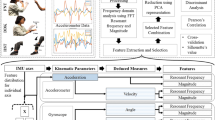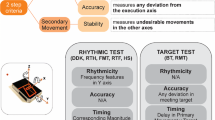Abstract
Cerebellar ataxia is a complex motor disturbance that involves the planning and execution of movements and reduces movement accuracy and co-ordination. The quantification of ataxic signs is commonly realised through visual examination of motor tasks performed by the patient and assignment of scores to specific items composing the international co-operative ataxia rating scale (ICARS). The present work studied an experimental procedure to characterise specific aspects of motor disturbances in ataxia objectively. Four tests belonging to the ICARS were considered: walking, knee-tibia test, finger-to-nose and finger-to-finger test. Through a kinematic analysis performed during the above tests, specific indices were defined to quantify velocity, linearity, asymmetry, tremor, instability and smoothness of movement or posture. The procedure was applied to five patients with cerebellar ataxia and to ten healthy adult subjects. Results demonstrated that the patients moved significantly more slowly than the healthy subjects (0.67 against 0.97 m s−1 and 0.81 against 1.02 m s−1, respectively, for straight walk and finger-to-nose tests) and showed poorer linearity and smoothness behaviour. Velocity, linearity, tremor, smoothness and instability indices showed moderate to good correlation with the corresponding ICARS score. Some of these indices can separately evaluate aspects that are combined in single ICARS subscores. It is concluded that the combination of clinical assessments and instrumental evaluations allows a better insight into ataxic patients' motor disturbances and is a useful tool for the definition and follow-up of rehabilitation programmes.
Similar content being viewed by others
References
Alusi, S. H., Glickman, S., Patel, N., Worthington, J., andBain, P. G. (2003): ‘Target board test for the quantification of ataxia in tremulous patients’,Clin. Rehabil.,17, pp. 140–149
Bastian, A. J., andThach, W. T. (1995): ‘Cerebellar outflow lesions: a comparison of movement deficits resulting from lesions at the levels of the cerebellum and thalamus’,Ann. Neurol.,38, pp. 881–892
Berg, K., Wood-Dauphinee, S., andWillams, J. I. (1995): ‘The balance scale: reliability assessment with elderly residents and patients with an acute stroke’,Scand. J. Rehabil. Med.,27, pp. 27–36
Cappozzo, A., Catani, F., Croce, U. D., andLeardini, A. (1995): ‘Position and orientation in space of bones during movement: anatomical frame definition and determination’,Clin. Biomech. (Bristol, Avon),10, pp. 171–178
D'Amico, M., andFerrigno, G. (1990): ‘Technique for the evaluation of derivatives from noisy biomechanical displacement data using a model-based bandwidth-selection procedure’,Med. Biol. Eng. Comput.,28, pp. 407–415
De Jong (1992): ‘The neurologic examination’, (Lippincott, Philadelphia, 1992)
Ebersbach, G., Sojer, M., Valldeoriola, F., Wissel, J., Muller, J., Tolosa, E., andPoewe, W. (1999): ‘Comparative analysis of gait in Parkinson's disease, cerebellar ataxia and subcortical arteriosclerotic encephalopathy’,Brain,122, pp. 1349–1355
Flash, T., andHogan, N. (1985): ‘The coordination of arm movements: an experimentally confirmed mathematical model’,J. Neurosci.,5, pp. 1688–1703
Fregly, A. R., andGraybiel, A. (1968): ‘An ataxia test battery not requiring rails’,Aerosp. Med.,39, pp. 277–282
Frigo, C., Rabuffetti, M., Kerrigan, D. C., Deming, L. C., andPedotti, A. (1998): ‘Functionally oriented and clinically feasible quantitative gait analysis method’,Med. Biol. Eng. Comput.,36, pp. 179–185
Giovannoni, G., van Schalkwyk, J., Fritz, V. U., andLees, A. J. (1999): ‘Bradykinesia akinesia inco-ordination test (BRAIN TEST): an objective computerised assessment of upper limb motor function’,J. Neurol. Neurosurg. Psychiatry,67, pp. 624–629
Hallett, M. (2001): ‘Cerebellar ataxic gait’,Adv. Neurol.,87, pp. 155–163
Holmes, G. (1917): ‘The symptoms of acute cerebellar injuries due to gun-shot injuries’,Brain,40, pp. 461–535
Lamperti, C., Naini, A., Hirano, M., De Vivo, D. C., Bertini, E., Servidei, S., Valeriani, M., Lynch, D., Banwell, B., Berg, M., Dubrovsky, T., Chiriboga, C., Angelini, C., Pegoraro, E., andDiMauro, S. (2003): ‘Cerebellar ataxia and coenzyme Q10 deficiency’,Neurology,60, pp. 1206–1208
Leone, M., Rosso, M. G., andTribolo, A. (1986): ‘Ataxia clinical rating scale in Friedreich disease’,Ital. J. Neurol. Sci.,7, pp. 61–62
Mitoma, H., Hayashi, R., Yanagisawa, N., andTsukagoshi, H. (2000): ‘Characteristics of Parkinsonian and ataxic gaits: a study using surface electromyograms, angular displacements and floor reaction forces’,J. Neurol. Sci.,174, pp. 22–39
Notermans, N. C., van Dijk, G. W., van der Graffe, Y., van Gijn, J., andWokke, J. H. (1994): ‘Measuring ataxia: quantification based on the standard neurological examination’,J. Neurol. Neurosurg. Psychiatry,57, pp. 22–26
Palliyath, S., Hallett, M., Thomas, S. L., andLebiedowska, M. K. (1998): ‘Gait in patients with cerebellar ataxia’,Mov. Disord.,13, pp. 958–964
Sanguineti, V., Morasso, P. G., Baratto, L., Brichetto, G., Mancardi, L. G., andSolaro, C. (2003): ‘Cerebellar ataxia: Quantitative assessment and cybernetic interpretation’,Hum. Mov. Sci.,22, pp. 189–205
Seidel, B., andKrebs, D. E. (2002): ‘Base of support is not wider in chronic ataxic and unsteady patients’,J. Rehabil. Med.,34, pp. 288–292
Stiles, R. N., andPozos, R. S. (1976): ‘A mechanical-reflex oscillator hypothesis for Parkinsonian hand tremor’,J. Appl. Physiol,40, pp. 990–998
Stolze, H., Klebe, S., Petersen, G., Raethjen, J., Wenzelburger, R., Witt, K., andDeuschl, G. (2002): ‘Typical features of cerebellar ataxic gait’,J. Neurol. Neurosurg. Psychiatry,73, pp. 310–312
Tinetti, M. E. (1986): ‘Performance-oriented assessment of mobility problems in elderly patients’,J. Am. Geriatr. Soc.,34, pp. 119–126
Trouillas, P., Takayanagi, T., Hallett, M., Currier, R. D., Subramony, S. H., Wessel, K., Bryer, A., Diener, H. C., Massaquoi, S., Gomez, C. M., Coutinho, P., Ben Hamida, M., Campanella, G., Filla, A., Schut, L., Timann, D., Honnorat, J., Nighoghossian, N., andManyam, B. (1997): ‘International Cooperative Ataxia Rating Scale for pharmacological assessment of the cerebellar syndrome. The Ataxia Neuropharmacology Committee of the World Federation of Neurology’,J. Neurol. Sci.,145, pp. 205–211
Wenzelburger, R., Raethjen, J., Loffler, K., Stolze, H., Illert, M., andDeuschl, G. (2000): ‘Kinetic tremor in a reach-to-grasp movement in Parkinson's disease’,Mov. Disord.,15, pp. 1084–1094
Author information
Authors and Affiliations
Corresponding author
Rights and permissions
About this article
Cite this article
Ferrarin, M., Gironi, M., Mendozzi, L. et al. Procedure for the quantitative evaluation of motor disturbances in cerebellar ataxic patients. Med. Biol. Eng. Comput. 43, 349–356 (2005). https://doi.org/10.1007/BF02345812
Received:
Accepted:
Issue Date:
DOI: https://doi.org/10.1007/BF02345812




